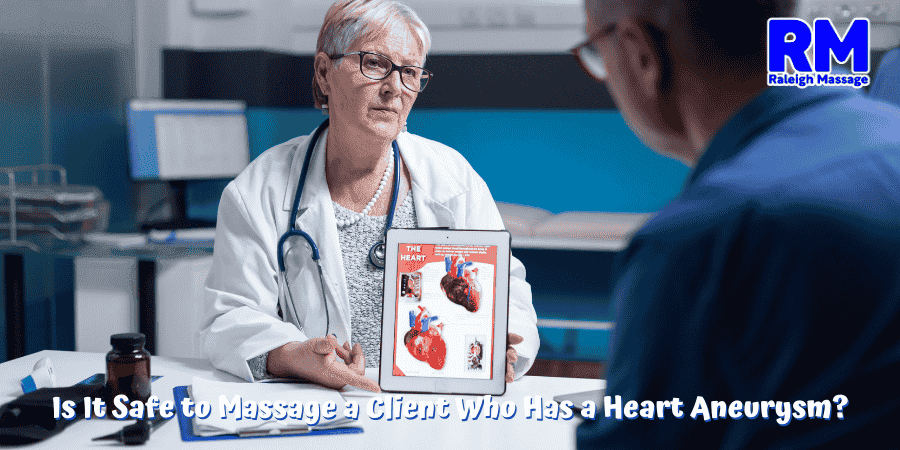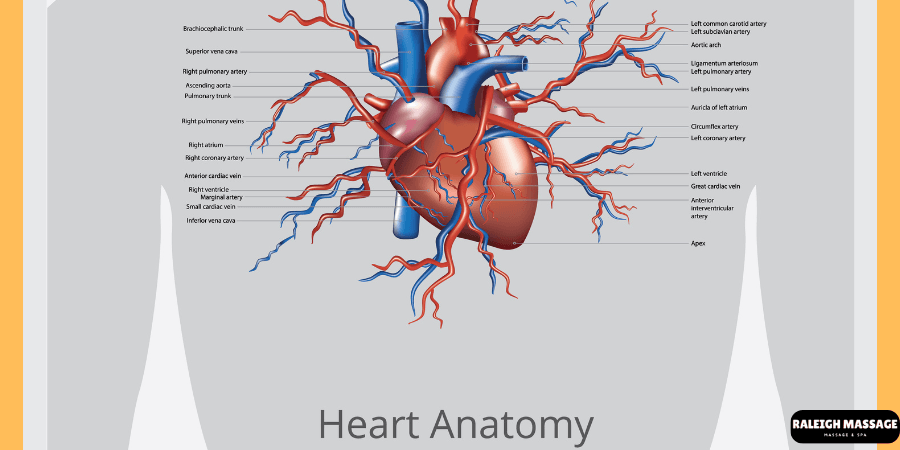With someone who has a heart aneurysm, it’s understandable to feel hesitant about massage. Heart aneurysm sounds scary, right? You may be wondering how something as innocuous as a massage could potentially be risky. Believe me, I’ve asked myself these same questions. But with the correct knowhow, you can make informed choices.
I’m here to explain, based on what I learned about this. Reading this blog should provide more peace-of-mind when it comes to knowing what to do and not do during a massage session when heart aneurysm is present.
What Is a Heart Aneurysm?
Before we get into whether massages are safe, let’s break down what a heart aneurysm actually is. Essentially, it’s a bulging out of the wall of a heart’s blood vessel or even part of the heart itself. Imagine a bulge in it, which can be frightening to imagine; but that’s a weak point. That weakness always carries the possibility of complications, particularly if pressure is created.
Heart aneurysms do not always produce symptoms. Some learn they have one by accident — during a routine physical exam or imaging test. Some may experience fatigue, chest pain or discomfort. Either way, it’s a condition that requires attentive care.
So does that mean massage is totally out of the question? The good news is, not always. But there are a few things you should consider first.
Can It Be Dangerous?
If your client has a heart aneurysm, their health is already in a delicate place. Any pressure, movement, or change in heart rate can affect them. That’s why jumping into a massage without asking questions is never a good idea. You need a clear understanding of their condition before touching the massage table.
One of the biggest risks involves blood pressure. Some types of massage increase blood flow and may raise blood pressure slightly. For someone with a heart aneurysm, even a small change in pressure can be unsafe.
Massage can also stimulate the nervous system. While for most people this is relaxing, for someone with a heart issue, it might trigger their heart to work harder. It’s scary to think about, and that’s why I can’t stress enough how caution is key.
Communication Is the First Step
Always, and I truly mean , ask detailed health questions before starting a massage. If a heart aneurysm comes up, you need to know the specifics right away. Is it small or large? Have they had surgery or are they considering it? How stable is their condition?
Don’t hesitate to request permission to speak with their doctor. Clients usually appreciate this. I’ve done this many times, and it always helps. Their doctor can offer advice or share red flags you should watch for.
And remember, if you’re unsure, it’s okay to say no. While I always want to help my clients, safety matters more than anything.
Types of Massage to Approach with Caution
Not all types of massage are appropriate, particularly for someone with a heart aneurysm. There are some gentle and safe methods, and there are some that require more consideration.
Deep-Tissue Massage
Guide: Deep-tissue massage is intense. It gets into the deeper layers of muscles and feels great to many people. But that may not be the best option for someone with a heart aneurysm. The pressure could cause strain on their blood vessels.
Swedish Massage
Swedish massage is gentler. That’s typically the safer route when treating someone with mild health issues. For heart aneurysms, lighter strokes may be permitted, but, again, it depends on the individual’s condition.”
Reflexology or Energy Work
If you’d like to avoid direct pressure completely, these can be alternatives. They concentrate more on particular sections, like the feet or hands, and less on general muscle adjustment. It could be a less intrusive and potentially safer introduction.”
When Is It Safe to Massage a Client Who Has a Heart Aneurysm?
The answer depends on multiple factors, but it comes down to communication and medical advice. If their doctor clears massage as safe, then proceed—but gently. Follow their advice to the letter.
Keep the massage light and slow. Avoid vigorous techniques or applying too much pressure near the chest or neck area. Always monitor how the client feels. Encourage them to speak up if they feel even the slightest discomfort.
Sometimes, clients don’t realize they can say “stop.” I’ve had clients stay silent through discomfort, thinking it’s normal or that they don’t want to offend me. I always reassure them—it’s their body and their session. They should speak up anytime.
Emotional Support Also Matters
When treating a person with a condition such as a heart aneurysm, you’re providing physical relief, sure, but you’re also providing emotional support. Illness can render people vulnerable and frightened. At times, they simply want someone to care or listen.
I discovered this with one of my clients who had a heart issue. She acknowledged that the massage wasn’t just for her body — what she really needed was less anxiety. Her doctor had cleared light, relaxing touch. I felt no pressure at all during her session. Instead, I decided to try a gentle head and hand massage. The relief she experienced afterward wasn’t just physical: she said it soothed her mind.
Little acts like this mean a great deal. Sometimes, the lightest touch is all that feels comforting.
Understanding Limitations
It’s tempting to think massage can solve everything. But the truth is, it can’t. When dealing with something as serious as a heart aneurysm, you have to accept your limitations as a therapist. This doesn’t make you less of a healer; in fact, it makes you a more responsible one.
Heart aneurysms, especially untreated ones, can be ticking clocks. While it’s rare for massage to trigger a severe event, why take the chance? Respecting these boundaries ensures you’re putting your client’s safety first.
My Approach in Practice
Whenever I encounter a client with a tricky health concern, I always follow a process. Here’s what I do:
- Start the Conversation. Ask about their medical history. Don’t hesitate to ask detailed questions about the heart aneurysm. Learn where it is and how stable it is.
- Consult a Professional. If needed, contact their doctor for advice. I’ve found this step creates trust—clients see that their safety matters.
- Keep Things Gentle. Choose light-pressure techniques. Avoid pushing too hard or using vigorous motions.
- Monitor Constantly. Watch for signs of discomfort. Encourage your client to give feedback during the session.
- Provide Emotional Reassurance. A little compassion goes a long way. Offer a calm, peaceful environment and show empathy for their concerns.
If you approach it this way, you’re more likely to ensure a safe and comforting experience.
In the end, being mindful when working with patients who have heart aneurysms is key. Is it safe to massage them? At times, yes — with appropriate precautions. But don’t be afraid to step back and seek out doctors or other experts when not sure.
This isn’t about fear. It’s respect—for the body, for the condition, and for your client’s broader health. By asking appropriate questions, keeping your ears to the ground, and listening, you will be in the best position to make the right calls for your clients.
If you’re looking for a space that values safety and comfort above all else, visit Raleigh Massage. We’re here to prioritize your wellness.
FAQs for heart aneurysm massage
1. Is it safe to give her a heart aneurysm massage?
Massage can be safe if cleared by a doctor. Soft, light-pressure techniques are often used here.
2. Where should I not massage for heart aneurysms?
Do not apply deep or strong pressure on the chest, neck or heart area. Go for gentle and soothing motions.
3. Will massage reduce stress for a person with a heart condition?
Yes, it can help lessen stress and anxiety, particularly when done using gentle techniques that emphasize relaxation over deep pressure.
4. Is a client with a heart aneurysm good for a massage with a doctors note?
Always best to consult their doctor first. NOTE: A consultation is vital for the security of both client and therapist.
5. Which types of massage are safer in case of heart aneurysms?
Swedish massage and reflexology are less intense. These emphasize relaxation, not deep manipulation of muscles.








